#animal ecology
Text
My thoughts of the new Minecraft wolf variants!
With the recent announcement of the new wolf variants, I wanted to give my two bits about what real life animal each of the variants are based on! (I study animal ecology so I get excited when animals are depicted in anywhere)
The Pale Wolf, Black Wolf, Snowy Wolf, Ashen Wolf, and Woods Wolf
All of these wolf variants are based on the Grey Wolf (Canis lupus), whether it be the typical Plains Wolf (Canis lupus nubilus), or a different subspecies. The Grey Wolf is the most common wolf species found on the world, typically lives in packs of 4-9 members, and typically has 5 accepted subspecies in the science community - but in total has over 30 subspecies (determining subspecies can be tricky).

The Pale Wolf is specifically meant to represent a Plains Wolf, as this design has been representing the Grey Wolf in Minecraft for at least 12 years. The Taiga biome is one of the biomes where Grey Wolves can be found, making it a great place to find Pale Wolves in Minecraft.

The Black Wolf is not a subspecies, but rather a color variant of the Gray Wolf. The black coloring of their coats is not typically caused by melanism, but rather is a normal gene found in Grey Wolves. One of the causes of wolves having a black coat is due to the black gene being linked to higher immunity to canine distemper, meaning the black wolves that survive the virus are able to reproduce and pass on their black genes. Does this mean distemper exists in Minecraft? Probably not, but that's up to your interpretation.

The Snowy Wolf is based on the Arctic Wolf (Canis lupus arctos). Artic wolves' white coats help them blend into the snow to help them hunt prey, and to hide them from potential predators.
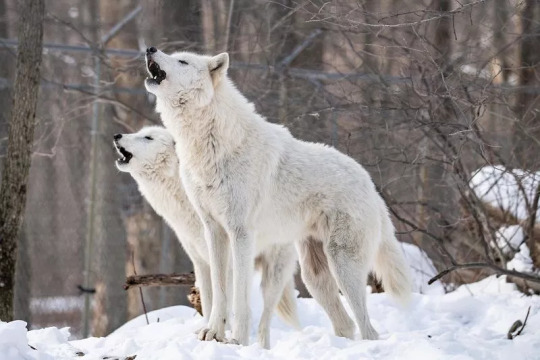
The Ashen Wolf is likely based on the Eurasian Wolf (Canis lupus lupus). The Eurasian wolf can have similar coloring to the plains wolf, but has also been found with greyer coloring along its back, tail, and upper legs and face, and with white on its cheeks, underbelly and lower legs.
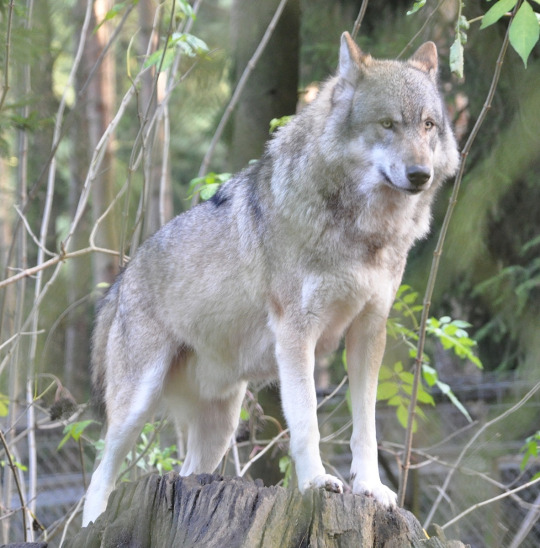
I think that the Woods Wolf is based on the Tibetan/Himalayan Wolf (Canis lupus chanco). It was a challenge to find what subspecies the woods wolf was based on because most wolves don't have the deep brown-orange coloring seen on the woods wolf, but the Tibetan/Himalayan wolf can often be seen with these colorings in the wild.
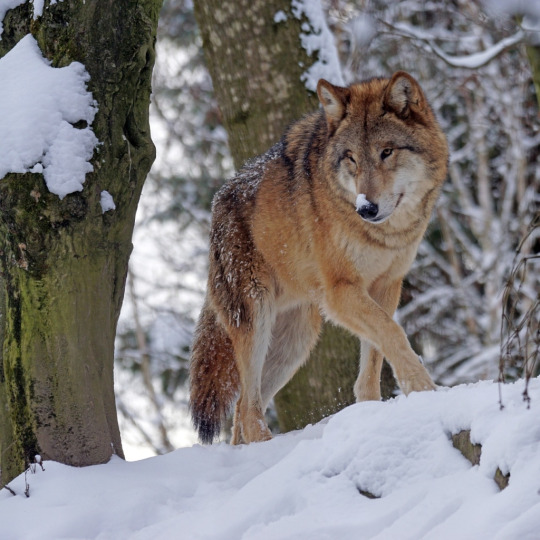
The Rusty Wolf
The Rusty Wolf is based on the Dhole (Cuon alpinus), also known as the Asiatic Wild Dog. Dholes have a rich tawny coat with a rich chocolatey tail. Unlike another popular red canine (the dingo), Dholes live in tropic forests, rainforests, and other habitats, making it an appropriate fit to be the jungle dwelling rusty wolf.

The Spotted Wolf
The Spotted Wolf is based on the African Wild Dog (Lycaon pictus), also known as the Painted Dog or the Cape Hunting Dog. This is variant is my favorite of the variants, and is one of my favorite canines of all time. African wild dogs live in savannah and grasslands biomes irl, and have beautiful coats ranging in different patterns of tawny, black, and white. I don't know if this is possible for Minecraft mechanics, but hopefully the spotted wolves will have different coat variants like their irl counterparts.

The Striped Wolf
The Striped Wolf is based on the Aardwolf (Proteles cristata), which is a species of hyena, making them felids instead of canids! (Yes, hyenas are more closely related to cats than dogs). Aardwolves can be found in semi-arid and open plains, making the badlands a good place to find them in-game. Fun fact! Aardwolves mainly eat termites/ants. Hopefully the striped wolf won't starve in a "bugless" game (rip fireflies).
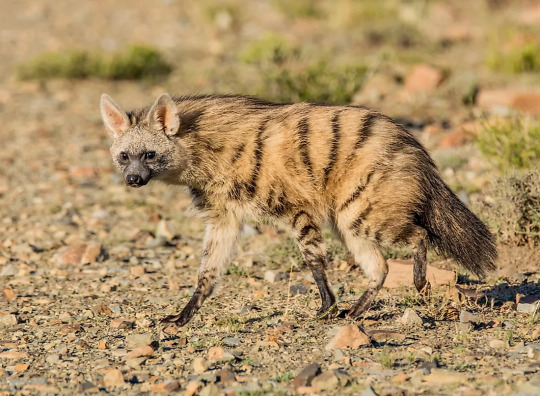
The Chestnut Wolf
This one frustrates me. I couldn't find a canine or canine adjacent animal that had even a similar coat pattern. This is not a wolf. It is a dog. Probably a Norwegian Elkhound.

#minecraft#minecraft wolf#minecraft wolves#wolf#wolves#grey wolf#dhole#african wild dog#aardwolf#norwegian elkhound#zoology#animal ecology
62 notes
·
View notes
Text
The Takin is such a whimsical herbivore, like God commissioned Dr. Seuss for this one.



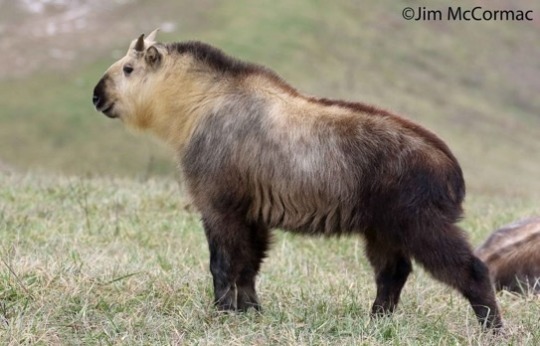
#speculative biology#speculative ecology#speculative evolution#speculative zoology#traditional art#traditional sketch#spectember#paleontology#specposium#fanart#animals#takin#cute animals#paleo meme#paleo#paleoillustration#paleo art#paleontologist#paleoblr#creature#shaggy animal#herbivore#dr. seuss
24K notes
·
View notes
Text
I got a fish book from the library and I just think everyone should know that archerfish aka the guys that spit jets of water at bugs to knock them off plants and eat them aka these guys-

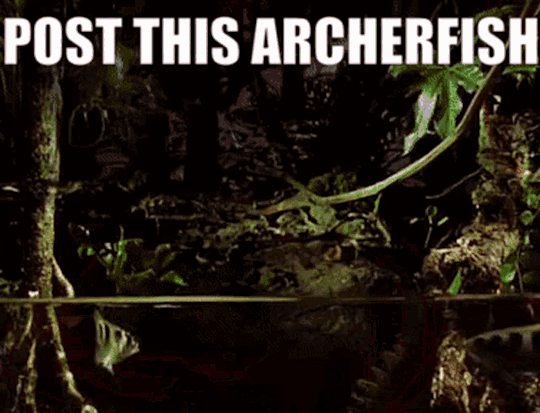
-are a social species (like a lot of fish), and that the jet spitting is actually a learned behavior rather than one they just do instinctually. They have to watch older members of their social groups do it a bunch of times (like up to thousands) before they're able to successfully do it themselves. If you take a young one and isolate it from its species, they just never get good at it (they also catch prey like "normal" fish tho, so an archerfish that can't archer won't starve just bc of that)
When they do learn to do it tho, they can compensate for light refraction, vary how much water they spit based on the size of the insect they're aiming for, and will learn to shoot insects that are midflight by spitting in the bug's flight path rather than where the bug actually is
22K notes
·
View notes
Text
A little over a decade ago, researchers in Australia were placing recorders in the nests of superb fairywrens (Malurus cyaneus) when they discovered something entirely unexpected.
The female songbirds were singing to their unhatched eggs.
Even more astonishing, when the chicks finally hatched, experts noticed that all the birds that grew up in the same nest used a similar tune to beg their mother and father for food.
Continue Reading.
6K notes
·
View notes
Text
golly, I am being wordy today.
Via Metafilter:
Someone on MeFi tagged me in and asked me to chime in in my capacity as a rodent person, so here were my thoughts and observations:
First thought, looking at that video: that is no house mouse. Not only is the head wrong--too narrow at the back, eyes are a bit big--but that very clear countershading is not something you generally see on wild house mice. So what kind of mouse is it? If this was in the US, I would assume it was a Peromyscus (deer mouse) species, which often gleefully invade our homes, but do they have Peromyscus in Wales? In North America, this is relevant because deer mouse species often have very elaborated burrowing and pair bonding systems, and this looks like nesting behavior off the top of my head. What sort of mouse is this?
The Woodland UK Trust suggests that this is probably a wood (or field) mouse: Apodemus sylvaticus. (There are glorious big photos there which can help you see what I mean.) Okay, I don't know that much about Apodemus spp. behavior, so what do we know about their nesting behavior?
Well, I chased a couple of false leads, then circled back to find out what is notable about wood mice, which is that they are known to not only navigate by the use of landmarks, but to organize their environments to place small objects around their environments in order to make navigation and orienting themselves across their large territories more effectively! So this mouse is probably irritably putting things back in place as an aid to its own memory of where everything is and where it can most effectively pilfer snacks, nest locations, or other useful mouse items within its environment. That is, the mouse wants a tidy shed for exactly the same reasons a human might want a tidy shed: so it can find things it's looking for when it wants to!
Wood mice, by the way, are human commensals and quite common in Europe and the British Isles, so this is in no way a refutation of the idea that this behavior might have influenced human folklore and ideas about house spirits or similar. Certainly wood mice, like any mouse, are unlikely to turn up a bowl of milk if there's one put out for it--although neither are house cats, which would certainly prey on them.
rather delighted, so I'm sharing this more widely over here.
6K notes
·
View notes
Text
Hey. You.
Check out this weird fish.

Cool, huh? It's got no bones and it's older than T rex. Wanna learn more? Check out Consider Nature:
#animals#science#biology#nature#conservation#wildlife#environment#fish#fishing#ecology#considernature
6K notes
·
View notes
Note
His name is penis and he was born without a brain.
Say something nice to him.
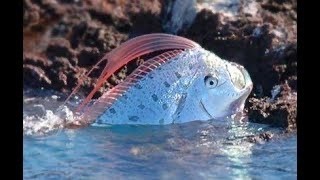
Hello Penis,
What you're missing in brains you make up for in 1,100 CM (36 FT) OF PURE FISH

Regalecus glesne or Oarfish
3K notes
·
View notes
Text
okay. so.
i'm reading this book The Origins of the Modern World by Robert Marks
and even from the beginning i was getting this weird feeling from it. I'm always really wary of books that are broad overviews of history that claim to explore big theory-of-everything explanations for very broad phenomena, because history is unbelievably complex and there is so much disagreement between historians about everything.
But anyway I come to this section (in the first chapter)
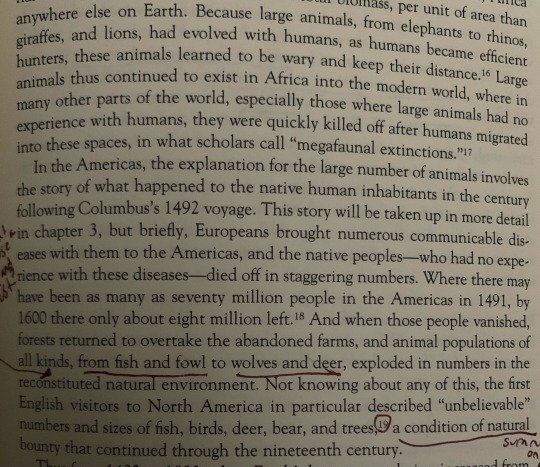
This writer's opinion is that the Americas seemed so abundant when English settlers first arrived because the Native Americans had been mostly killed, and as a result, the wildlife increased greatly in numbers and forests overtook the farms, creating what appeared to be a natural paradise.
I'm immediately suspicious of this paragraph because arguing that the mass death of Native Americans was good for nature seems really contradictory to the research I've explored, on top of being just...disgusting.
But it doesn't sound right in regards to how ecosystems work either. If populations of animals had recently exploded after millennia of being limited by a major predator, it would cause the plants to be overwhelmed by the herbivore populations. The land would be stripped barren and eroded, and soon the animals would be weak and starving.
So I thought to myself, huh, a citation. I will look at the citation and see what it says.
It's a book called Changes in the Land by William Cronon, who seems to be one of the most important and respected guys in his field. I thought, I have to find this book. So I did, I found the book, and spent like an hour reading through it.
And what I discovered, is that Cronon's book directly contradicts what Marks says in the paragraph that cites Cronon?!

So basically this entire book, Changes in the Land, is a detailed exploration of how the arrival of English settlers, the decline of Native American populations, and the slow transition to European farming and land use practices caused increasing degradation to the ecosystem, beginning very early on in colonization.
Changes in the Land quotes a great array of documents from the colonial period where settlers observed the soil becoming depleted, animals disappearing, and the climate itself becoming more hostile even in the 1600's. It's actually a really fascinating book.
Cronon tells us that Native Americans created lush and abundant conditions for wild animals by causing a "mosaic" of habitats, with different areas representing various stages of ecological succession. With this great diversity in habitats, and lots of transitional "edges" between them, the prosperity of the animal life was maximized. This was intentional, and really a type of farming.
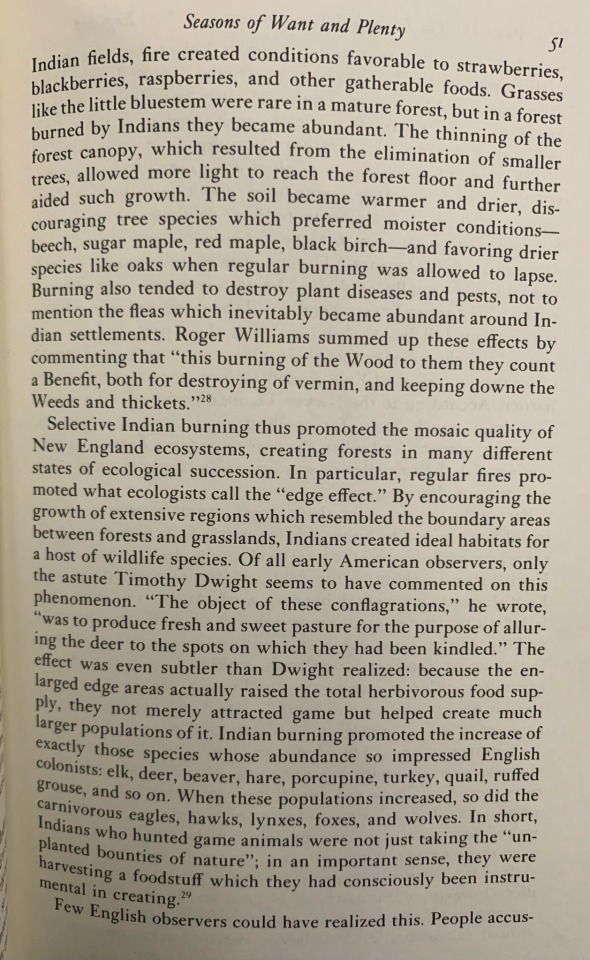
The book essentially explains how European settlers couldn't recognize Native American life ways as "agriculture," they thought the land was just supernaturally abundant all by itself because of its inherent nature, and yet almost immediately after settlers came, the abundance of the land degraded and vanished. The settlers cut down vast amounts of trees, which caused erosion, which destroyed the river and stream ecosystems and starved the soil of nutrients. Destruction of forest caused less rain, and more extreme temperatures. It became a vicious cycle where the settlers had to abuse the land more and more just to survive.
The spiral pulled in Native American communities too, forcing them to turn to more exploitative means of survival like the fur trade, (which depleted the beaver population, which caused the decline of beaver ponds, which harmed the whole forest). It describes how the changing ecosystems left Native Americans with no choice but to turn to European practices for survival, which in turn depleted the land even further.
Even I was surprised to learn just how early on environmental disaster set in, and the incredible extent of it. English farming practices literally reshaped the map of New Haven between the 17th and 18th centuries:
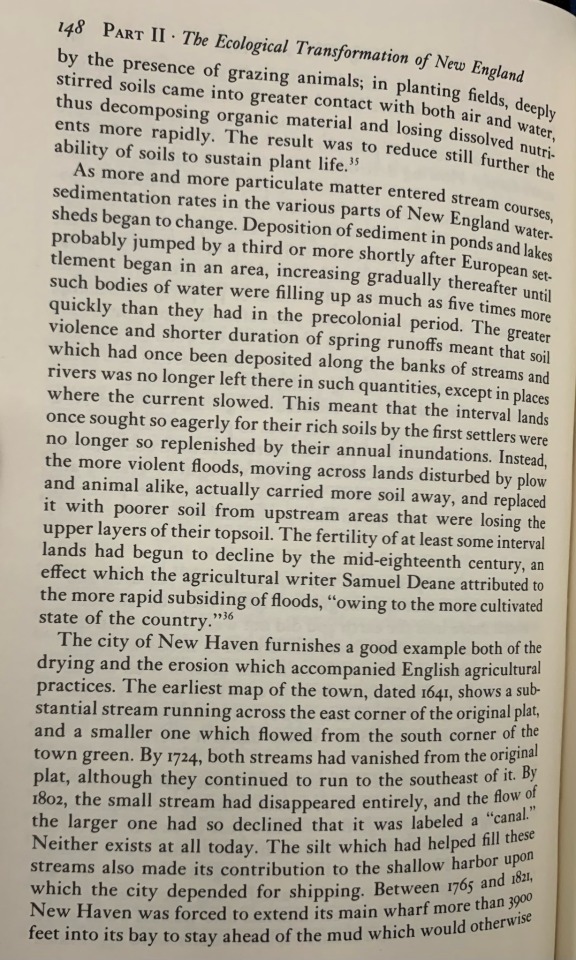
To return to Marks, though...Marks' statement in the excerpt, where he says the "abundance" of animals continued throughout the 19th century, is blatantly false according to the source HE CITES.

Deer were becoming scarce in New England by the 1690's. It was so bad by 1718 that deer hunting was forbidden for 3 years at that time, and by 1800, deer were almost extirpated from New England. The book explains on another page that wild turkeys became so rare that a farmer's manual from the time said their domesticated turkeys were from Turkey—settlers had no opportunity to see a wild turkey and no idea they existed.
Marks is supporting his statement using a source entirely dedicated to contradicting the exact thing he's saying! It's unbelievable.
How does this happen? Did Marks just have his own opinion and insert a famous book that seemed to be on the subject as support, without reading it?
I'm thinking now of all the times I've read a book and seen a citation on a statement and unconsciously thought "oh, well it seems there is evidence, so it must be reliable" when actually, something like this was happening. The array of ways misinformation can be propagated and never be found out is terrifying.
2K notes
·
View notes
Text

#laios#dungeon meshi#laios touden#his hungry ass could never#the nungriest boy#i just imagined him doing a crocodile hunter type show but he kills and eats every animal he sees after explaining their ecology
2K notes
·
View notes
Text
The population of giant pandas in the wild has nearly doubled as China steps up its conservation efforts.
China’s National Forestry and Grassland Administration said on Jan 25 there are now around 1,900 pandas in the wild from some 1,100 in the 1980s.
This has been due to China’s efforts to protect the species, considered a national treasure, said Mr Zhang Yue, an official with the administration.
The Giant Panda National Park was established in October 2021, covering a total area of over 22,000 sq km and providing a home to around 72 per cent of the wild giant panda population.
Protected areas for giant pandas have grown from 1.39 million ha to 2.58 million ha since 2012.
The International Union for Conservation of Nature has adjusted the status of giant pandas from “endangered” to “vulnerable”.
“This indicates that China’s giant panda conservation efforts have been recognised by the international wildlife conservation community,” Mr Zhang said.
The global captive population of giant pandas, meanwhile, has now reached 728, with 46 pandas successfully bred in captivity in 2023.
The genetic diversity of captive giant pandas has also improved. The current captive population of giant pandas can maintain 90 per cent genetic diversity for up to 200 years.
As for giant pandas living abroad, Mr Zhang said China has organised field inspections and assessments of 23 overseas cooperation institutions in 19 countries since 2023.
“The cooperation institutions generally meet the requirements in terms of venue construction, feeding and nursing, and disease prevention and control measures,” Mr Zhang said, adding that pandas living abroad are generally “in good health”.
He said China will further improve the international cooperation management mechanism for giant pandas, carry out regular daily health monitoring and field inspection and assessment, and continue to strengthen cooperation with international partners for the protection of endangered species and biodiversity.
-via The Straits Times, January 25, 2024
#panda#panda bear#pandas#china#endangered species#conservation#conservation news#conservation efforts#conservation practices#ecology#wildlife conservation#zoo animals#zoology#wildlife#wild animals#national park#giant panda national park#icun#good news#hope#hopepunk
998 notes
·
View notes
Text
If you aren't following the news here in the Pacific Northwest, this is a very, very big deal. Our native salmon numbers have been plummeting over the past century and change. First it was due to overfishing by commercial canneries, then the dams went in and slowed the rivers down and blocked the salmons' migratory paths. More recently climate change is warming the water even more than the slower river flows have, and salmon can easily die of overheating in temperatures we would consider comfortable.
Removing the dams will allow the Klamath River and its tributaries to return to their natural states, making them more hospitable to salmon and other native wildlife (the reservoirs created by the dams were full of non-native fish stocked there over the years.) Not only will this help the salmon thrive, but it makes the entire ecosystem in the region more resilient. The nutrients that salmon bring back from their years in the ocean, stored within their flesh and bones, works its way through the surrounding forest and can be traced in plants several miles from the river.
This is also a victory for the Yurok, Karuk, and other indigenous people who have relied on the Klamath for many generations. The salmon aren't just a crucial source of food, but also deeply ingrained in indigenous cultures. It's a small step toward righting one of the many wrongs that indigenous people in the Americas have suffered for centuries.
#salmon#dam removal#fish#animals#wildlife#dams#Klamath River#Klamath dams#restoration ecology#indigenous rights#Yurok Tribe#Karuk Tribe#nature#ecology#environment#conservation#PNW#Pacific Northwest
14K notes
·
View notes
Text
Lobe finned versus ray finned fish

Short answer: ray finned fish evolved from from lobe finned fish
Long answer: Lobe finned fish were dominant for a long time in the waters before they climbed up onto land and evolved into you, dear reader. This occurred around 400 MYA (million years ago). Sometime before that, about 425 MYA, ray finned fishes had evolved, but remained relatively small. This was until the permian mass extinction (290-245 MYA), when many lobe finned fish died out, and ray finned fishes (teleosts) were left to flourish and evolve to fill the empty evolutionary niches. The only lobe finned fish left behind today are the elusive coelacanths and lungfish. ***AND*** as the awesome people in the notes would like me to add, all tetrapods (tetra meaning four, pod meaning foot) are phylogenetically lobe finned fishes as well. this means amphibians, reptiles, and mammals.
@marinebiologyshitposts @fuckyeahcoelacanths
#marine biology#lobe finned fish#ray finned fish#coelacanth#evolution#science#things ya should know#zoology#biology#ecology#animal facts#animals
1K notes
·
View notes
Text
When hunting for mice in winter, red and Arctic fox are known to plunge headfirst at speeds of 2–4 meters per second, but their sharp noses reduce the impact force in snow and protect them from injury, according to a new Cornell University study.
The fundamental research sheds light on the biomechanics of the unique hunting behavior (known as mousing), advances our understanding of animal adaptations and offers insights into snow injuries people experience during snowboarding or skiing.
The study appears in the Proceedings of the National Academy of Sciences.
Continue Reading.
752 notes
·
View notes
Text
Wet Beast Wednesday: moray eels
This week on Wet Beast Wednesday I'll be going over something amazing, a fish with a sense of morality. You see, the moral eel is known for, what... I think I'm reading this wrong. Oh, MoRAY eel, not moral. Well this is awkward. Hang tight, I need to go redo my research.

(Image: a green moray (Gymnothorax funebris) swimming outside of its burry, with its whole body visible from the side. It is a long, slender fish that looks a bit like a snake. A long fin starts just below the head and continues down the length of the body. The body is arranged in a wave pattern. It has a pointed snout and small eyes. Its body is a yellow-green color. In the background is the sandy seafloor, dotted with various sponges and corals. End ID)
Moray eels are true eels, meaning they are in the order Anguiliformes. Yeah, I did wolf eels, electric eels, and lamprey eels before I got around to actual eels. There are over 200 known species of moray eel in 15 genera. Like other eels, they are elongated bony fish with extra vertebrae and reduced fins. Moray eels have fewer fins than most eel species, only having a dorsal, anal and tail fin that merge together and run down the back of most of the body and underneath portion of it. They achieve motion by undulating this long fin and sometimes undulating the rest of the body as well. Moray eels aren't the fastest of fish, but they can swim backwards, something almost no fish can. The head has a long snout with wide jaws. Most species have long fangs used to grab onto prey, but a few species are adapted to eat hard-shelled prey and have molar-like teeth to crush through shells instead. Probably the coolest feature of morays are the pharyngeal jaws. This is a second set of jaws located in the back of the mouth. When the eel bites onto prey, the jaws can be shot forward to grab the food and help pull it into the throat. While lots of fish have pharyngeal jaws, morays are the only ones who can extend their pharyngeal jaws forward and use them to grab prey. Morays have smooth, scaleless skin that is often patterned to provide camouflage. The skin is coated in mucus that provides protection from damage and infection. In some species, the mucus can be used to glue sand together to help reinforce burrows. Morays lack lateral lines, a system of organs found in most fish that senses changes in water movement. Their sense of smell is their primary sense. The size of morays varies between species. The smallest species is the dwarf moray eel (Gymnothorax melatremus) which reaches 26 cm (10 in) long. The largest species by mass is the giant moray eel (Gymnothorax javanicus) which can reach 3 meters (10 ft) and 30 kg (66 lbs) while the longest species is the slender giant moray (Strophidon sathete), the longest known specimen of which measured in at 3.94 m (12.9 ft).

New reaction image
(Image: a giant moray (Gymnothorax javanicus) emerging from a burrow. It is brown and mottled with yellowish patches. Its head is pointed at the camera and it's mouth is wide open, aming it look shocked. End ID)

(Image: an anatomical diagram of the skeleton of a moray eel emphasizing the pharyngeal jaws and the muscle attachments. End ID. Art by Zina Deretsky)
Moray eels are found throughout the Atlantic, Pacific, and Indian oceans. Different species are found in different temperatures and depths, though most species live in relatively shallow, warm water. Several species can live in brackish water and a few will swim upriver and live for a time in fresh water, though there do not appear to be any species that live their entire lives in fresh water. Morays are ambush predators who rely on the element of surprise. They live in small, tight places such as holes in coral, gaps between rocks, or sandy burrows. When prey passes, the eel can lunge out and grab it. Unlike most fish, the eel cannot use suction feeding due to the shapes of their mouths. They have to rely on lunging froward and catching prey with their mouths. Their mouths are adapted in shape to push water to the sides. This reduces water resistance and avoids creating a wave that could push prey away from the eel. If an eel catches prey that cannot be swallowed whole, it will tie itself in a knot while biting on to the food. By pulling its head through the loop, the eel can rip the food into bite-sized pieces. Spending most of their times in burrows also provides protection from predators, especially in juveniles or smaller species. At night, the eels will come out of their burrows to hunt sleeping prey while the larger predators are asleep. Giant morays have also been seen engaging in interspecies cooperative hunting with roving coral groupers (Plectropomus pessuliferus). The eels can fit into small crevices the groupers can't to flush prey into the grouper's path while catching their own. Morays are mostly solitary species and many can be territorial. They are known to be shy and will retreat into their burrows if they feel threatened. They are also curious and many species are quite intelligent.
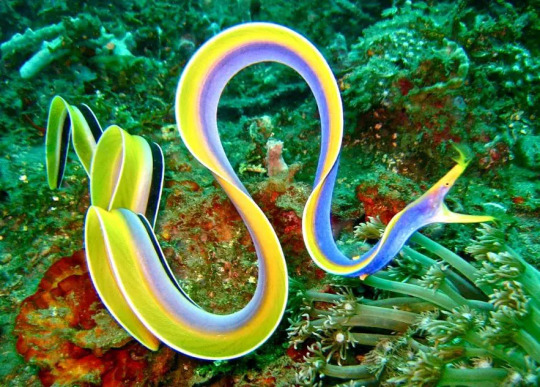
(Image: a male ribbon eel (Rhinomuraena quaesita) on a coral reef. It is a very long and slender eel with its body curved in many waves. It is brightly colored, with a blue-purple body, yellow fin and face, and a long black and white stripe running down the back half of the body. On the nostrils are two feather-like structures. End ID)
Morays reproductive strategies are poorly known and differ based on species. While many species seem to have no set mating season and will reproduce whenever they can, others will mate at the same time every year. Some species seem to have dedicated spots to lay their eggs and a few are believed to be anadromous, meaning they travel from the sea to fresh water to spawn. Meanwhile, some of the species that spend a lot of time in fresh water are catadromous, meaning they return to sea to mate. Females will lay their eggs and the male fertilize them. After this, they depart, providing no parental care. As with all true eels, moray eels begin life as leptocephalus larvae. This type of fish larvae is notable for its resemblance to a simple, transparent leaf with a head on one end. These larvae are unique and poorly understood, despite being the larval stage of a lot of different species of fish. They are unusually well developed for larvae, capable of active swimming and generally living life. In fact, some particularly large leptocephalus larvae were initially mistaken for adult fish. They feed mostly on bits of drifting organic material called marine snow and can remain in the larval stage for up to 3 years, with those in colder conditions usually taking longer to metamorphose. All leptocephalus larvae start out with no sex organs, then develop female organs, then develop male ones, becoming simultaneous hermaphrodites. They will ultimately become eith male or female and it is likely that environmental factors are the main determining factor. During metamorphosis into a juvenile, the leptocephalus can reduce in size by up to 90%, resulting in the juvenile being smaller than the larva. The process of maturation is poorly understood, but it seems that most morays will be sexually mature by three years of age.

(Image: multiple photos of a particularly large leptocephalus larva (not sure what species). It is a translucent organis, wth a body shaped like a very long leaf, narrow at both ends. In the frint is a very tiny head. End ID)
Morays are shy and generally avoid humans. Though some cultures have hunted them for food, they are often not considered a particularly good food source. Many species have high levels of chemicals called ciguatoxins in their bodies, which can lead to a condition called ciguatera fish poisoning if eaten. The largest threat to morays is habitat loss. This is especially true for the many species that live in coral reefs, which are in increasing danger due to global warming. Attacks on humans are rare and usually happen as a response to a human sticking their hand in the eel's burrow. Some of the large species could cause significant damage with a bite. Some species, usually the smaller ones, are found in the aquarium trade, thought they are not good pets for beginners as even the smallest morays are still large for aquarium fish and have some specific requirements. The curiosity many morays have has led to some becoming familiar with and even friendly to humans, often the result of feeding them. They can recognize individual humans and remember them over the course of years. Aquarium employees sometimes report that the eels will come to nuzzle and play with them and have personalities like dogs. Marine biologists and professional SCUBA divers Ron and Valorie Taylor befriended a pair of eels they named Harry and Fang at the Great Barrier Reef who would remember them and come out to visit them year after year.
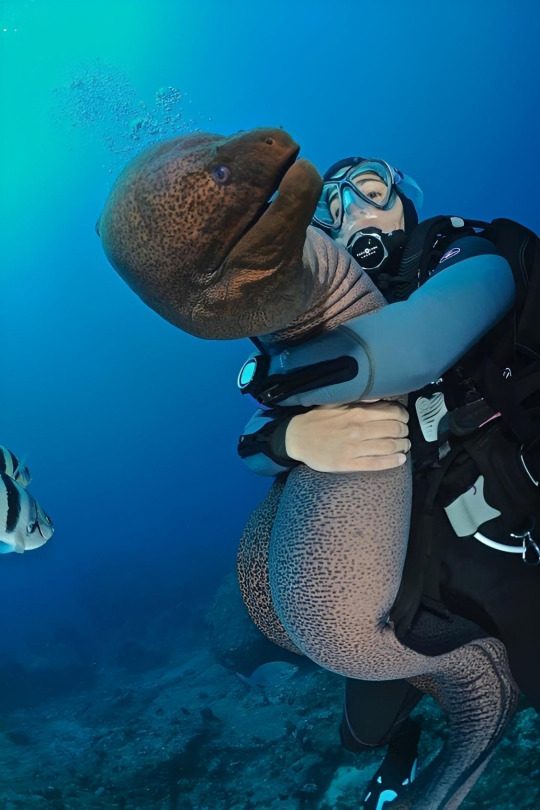
(Image: a SCUBA diver hugging a large, brown moray with black spots. End ID)
youtube
(Video: A shot video showing Valeria Taylor and a moray eel she befriended)
youtube
(Video: the song "That's a Moray", a parody of the song "That's Amore" by Dean Martin)
#wet beast wednesday#i accidentally typed moron eel more than once#moray eel#eel#anguiliformes#fish#bony fish#fishblr#fishposting#eelposting#marine biology#biology#ecology#zoology#animal facts#informative#image described#that's a moray#educational#Youtube
701 notes
·
View notes
Text
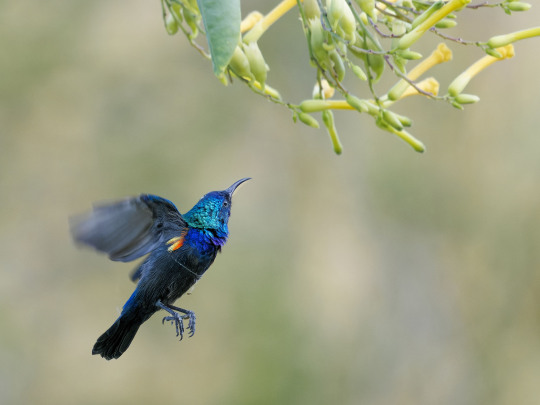

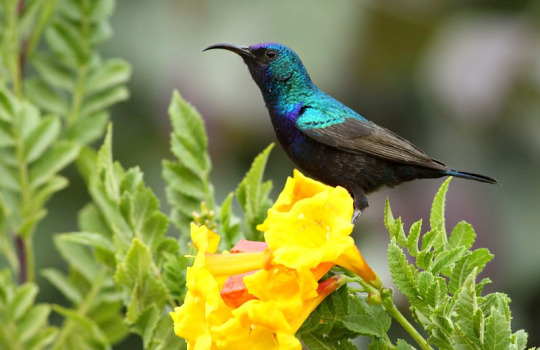
The Palestine Sunbird Persists
The Palestine sunbird, also known as the orange-tufted sunbird (Cinnyris osea) is the national bird of Palestine, and often seen as a symbol of resistance and hope. This species occurs in dry climates, particularly desert, scrubland, and savannahs, but can also be found in orchards and gardens where flowers are abundant. In addition to the Levant, C. osea occurs throughout the southwest cost of Saudia Arabia and the coasts of Yemen and Oman in the south.
C. osea is a small bird, 8 to 12 cm (3.1-4.7 in) long with a wingspan of only 14 to 16 cm (5.5-6.2 in). Males weigh on average 7.6 g (0.26 oz) and females are slightly smaller, at about 6.8 g (0.24 oz). Males are quite easy to identify due to their striking plumage; their feathers are iridescent, appearing dark until they shimmer glossy blue or green, with orange tufts at the side of the breast. In contrast females are fairly drab; grey-brown with a lighter underside. The beaks of the Palestine sunbird are also noted for their distinctively long and curved, which they have developed to efficiently feed on nectar.
Although not directly part of the hummingbird family, the Palestine sunbird shares many similarities with the group. Its diet consists of nectar, and is supplemented with insects. Their tongues are long, and brush-like, and the shape of their beak allows them to reach down to the base of the flower. For flowers that are , they will use their sharp beaks to pierce the side and access the nectar directly. All this is done at very high speeds, but unlike hummingbirds the Palestine sunbird cannot hover in place, and must land in order to feed. Because of their primary reliance on nectar, the orange-tufted sunbird is an important pollinator in its native region. Adults are rarely predated upon, but eggs and young are often targets for lizards, snakes, and birds of prey.
Reproduction begins in June, and continues through October. Males establish and defend territories, and court females by singing to attract a potential mate, then chasing her until she perches to signal her acceptance. Following the pairing, the two construct a purse-like nest, sometimes with a porch-like structure, that hangs from a branch. In this nest, 1-2 eggs are laid, and are incubated primarily by the female, while the male provides her food. The eggs take 13 to 14 days to hatch, and chicks are taken care of by both parents for an additional 14 to 21 days. Individuals can live up to 5 years in the wild.
Conservation status: The Palestine sunbird has a large range and population, and is thus considered Least Concern by the IUCN. Its primary threat is habitat loss due to agriculture and urban development.
If you send me proof that you’ve made a donation to UNRWA or another organization benefiting Palestinians, I’ll make art of any animal of your choosing.
Remember, the donation can be in any amount– every dollar counts!
Photos
Jorrit Vlot
Dula Alhashimi
Rana Hijawi
#Palestine sunbird#Passeriformes#Nectariniidae#sunbirds#perching birds#birds#deserts#desert birds#scrubland#scrubland birds#savannah#savannah birds#urban fauna#urban birds#middle east#animal facts#biology#zoology#ecology#free palestine
856 notes
·
View notes
Note
can you do one about vampire squids ? 🦑

Vampyroteuthis infernalis or Vampire Squid
It's (very dramatic) scientific name means "vampire squid from hell". However, the vampire squid is not actually a squid! It's actually the only animal in the Vampyroteuthidae family! It's separated into its own family because it can't change color or produce ink. Instead, it turns itself "inside out" (as shown above) to deter predators.
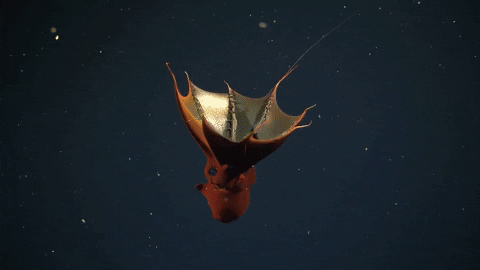
Proportionally, vampire squids also have the largest eyes compared to their body size! They eat mostly zooplankton, marine snow, and other organisms waste. They grow to be about the size of a football and live to be around 8 years old.

There's even evidence that vampire squids have been around since the Jurassic period- almost 200 million years ago!
#marine biology#marine ecology#animals#science#biology#animal facts#wildlife#marine life#ocean#fun facts#vampire squid#cephalopods#sea creature#squid#sea animals#sea creatures#sea animal#cool animals#zoology#ichthyology#sea#seas#oceans#the ocean#deep sea#jurassic period#fun animal facts#weird animal facts
1K notes
·
View notes